Incidence of nosocomial pneumonia in two intensive care units of a French University Hospital from 2016 to 2022 in the era of COVID-19 pandemic
IF 1.9
Q3 INFECTIOUS DISEASES
引用次数: 0
Abstract
Background
Hospital-Acquired Pneumonia (HAP) are common in intensive care units (ICUs). The COVID-19 pandemic led to a global increase in healthcare-associated infections (HAI) among ICU patients. The aim of this study was to evaluate the trends in HAP incidence over a seven-year period of surveillance in two ICUs at a French University Hospital, and to assess the impact of COVID-19 (as well as the associated bacterial ecology).
Methods
A prospective surveillance of HAI in ICUs was conducted during the 1st quarter of each year between 2016 and 2022 (2020: reference year). Socio-demographic, clinical and bacteriological data were collected and the incidence of HAP was calculated. Poisson regressions were done and crude and adjusted incidence rate ratio were calculated.
Results
1,797 patients were included, with 61.3% of male and a median age of 67 years. The median duration of intubation was 4 days (7 days in 2021 and 5 days in 2022). The proportion of COVID-19 patients was 45.7% in 2021 and 24.1% in 2022. Compared to 2020, the incidence of HAP increased in both 2021 [cIRR: 2.34 (95%CI: 1.30–4.23) and aIRR: 2.26 (95%CI: 1.25–4.08)] and 2022 [cIRR: 1.79 (95%CI: 0.97–3.32) and aIRR: 1.66 (95%CI: 0.90–3.07)]. The most commonly identified microorganisms were Enterobacteriaceae (42.4%), with a significantly higher incidence of HAP due to Enterobacteriaceae in COVID-19 patients.
Conclusions
These results indicate an increase of HAP incidence in 2021 and 2022, mainly caused by Enterobacteriaceae in COVID-19 patients. This trend needs to be confirmed or refuted in the post-pandemic era.
新冠肺炎大流行时期2016 - 2022年法国某大学医院2个重症监护室院内肺炎发病率分析
背景:医院获得性肺炎(HAP)常见于重症监护病房(icu)。COVID-19大流行导致全球ICU患者中医疗保健相关感染(HAI)增加。本研究的目的是评估法国大学医院两间icu在7年监测期间的HAP发病率趋势,并评估COVID-19的影响(以及相关的细菌生态)。方法2016 - 2022年(2020年为参照年),每年第一季度对icu进行HAI前瞻性监测。收集社会人口学、临床和细菌学资料,计算HAP发病率。进行泊松回归,计算粗发病率比和校正发病率比。结果纳入1797例患者,男性61.3%,中位年龄67岁。插管时间中位数为4天(2021年为7天,2022年为5天)。2021年新冠肺炎患者比例为45.7%,2022年为24.1%。与2020年相比,2021年的HAP发病率增加[cIRR: 2.34 (95%CI: 1.30-4.23)和aIRR: 2.26 (95%CI: 1.25-4.08)]和2022年[cIRR: 1.79 (95%CI: 0.97-3.32)和aIRR: 1.66 (95%CI: 0.90-3.07)]。最常见的微生物为肠杆菌科(42.4%),其中COVID-19患者因肠杆菌科引起的HAP发生率显著高于其他微生物。结论2021年和2022年新冠肺炎患者HAP发病率呈上升趋势,主要由肠杆菌科引起。这一趋势需要在大流行后时代得到证实或驳斥。
本文章由计算机程序翻译,如有差异,请以英文原文为准。
求助全文
约1分钟内获得全文
求助全文
来源期刊

Infection Prevention in Practice
Medicine-Public Health, Environmental and Occupational Health
CiteScore
4.80
自引率
0.00%
发文量
58
审稿时长
61 days
 求助内容:
求助内容: 应助结果提醒方式:
应助结果提醒方式:


